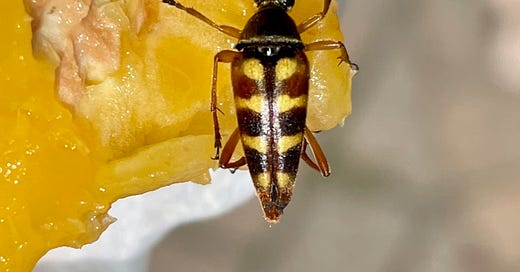I did my part for nature today.
I rescued a beetle from the death trap that is our screened-in porch.
Two days he’d been there,
Two days his menacing shape, in the shadowed corner of our porch, kept me away.
But I love a good insect rescue – the kind most find insignificant.
So when I finally discovered he wasn’t threatening,
Because I stood on the chair, feet straddling the thick metal bars so I wouldn’t have to stand on the flimsy strappy middle under the cushion of the patio chair,
I could sense his stress, his endless walking, circling, searching
in his tiny world of a 10 inch diameter.
I laid a piece of paper beside him and waited patiently for him to walk on.
He stepped one little tiny forked beetle claw on the paper, paused, and stepped back.
I’m always fascinated by insect and animal instincts;
Who needs complicated minds that get in the way when instinct is all you need to survive?
I grabbed my peach pit that was wrapped up in a paper towel on the table nearby,
Still retaining some fleshy bits of fruit
And gently nudged it right beside him.
He took one confident step on the fruit with one beetle leg, then another.
Then four more.
We stepped into freedom. He was free to go
but he was hungry and fresh summer peaches are a treat for all.
He lingered for a long while, but in the most peculiar way,
He looked as if he were praying,
head positioned downward, touching the peach.
‘Thank you for this meal. Thank you for this rescue.’
(All creation gives thanks and sings praise)
I grabbed my phone to take a picture and ID him from the iNaturalist app:
Genus Typocerus; it’s either a Zebra Longhorn or Banded Longhorn beetle, both common in my area.
He finally lifted his head and I saw his large eyes.
Was he looking at me, too, now?
I videoed him from my phone and zooming allowed me to see more than I could with my eyes.
He was chewing peach flesh; his mouth parts moving wildly, like an alien,
like nothing human, yet so incredibly human.
He sat on the peach for a long time and eventually flew off.
I know these beetles love flowers.
We have plenty in our yard for him to enjoy.
Nectar from a sweet peach, nectar from a garden gladiolus,
Summer breezes carrying him along the way.
Stranded from that life,
I’d want a rescue badly, too.
We keep the screened in porch door open so our dog can come in and out.
I will remain on the insect rescue team,
And continue to do my part for nature.
Naturalist’s note
As a master naturalist, I have a love hate relationship with many species of insects and flora. Love, because I love all creatures great and small and appreciate that they all, even the pests and menacing ones, serve a greater purpose in their ecosystems. Hate, because I also understand the difference between native and invasive species and how harmful invasive species can be to an ecosystem.
There are many different species of longhorn beetles, like the one above. Some are quite harmful to our gardens and others are not. Since I cannot accurately ID this one, I won’t speak to its characteristics other than to call out the interesting ‘wasp’ like pattern on its elytra, the hard forewings. This is an example of insect mimicry, called Batesian mimicry, and its purpose is to imitate warning signals of a harmful species directed at a predator; ultimately, it’s purpose is to survive. There are many insects that mimic wasps because there are many predators that try to avoid wasps.
So, the next time you think you might be staring at a wasp and instantly become frightened and try to swat it or kill it, look closely (though, carefully as it might be a wasp) because it may be a mimic.





